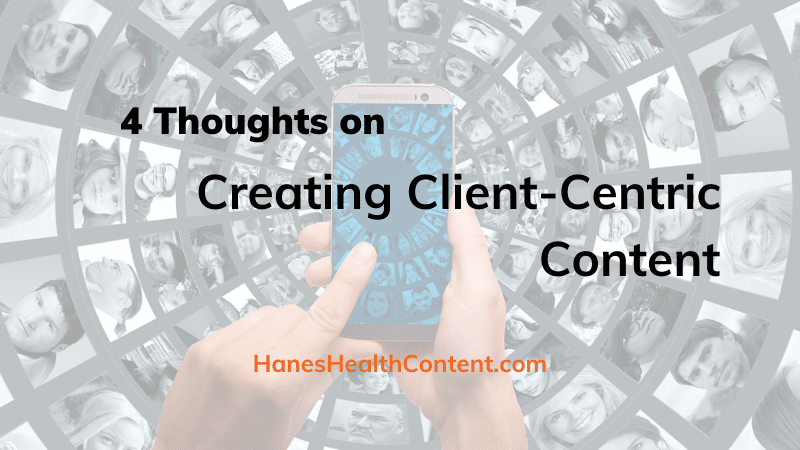In my life as a freelance healthcare writer, I often encounter smaller clients – like solo physician practices or small medical groups – that take a broad spectrum approach to their content. They “want it all:” blog posts and social media updates and brochures and a podcast.
But taking this type of scattershot approach to your content can literally cost you money, first by paying the content creator for needless assets and second by creating assets that don’t reach (or resonate with) your intended audience.
Let’s be smarter than that. These four considerations for creating patient- or client-centric content maximize value both to you and to the consumer.
1. Make intelligent decisions about content format
Many providers and small healthcare brands succumb to the “digital marketing du jour” approach. For example, podcasting is a current darling, so they want to start a podcast.
But a better approach is to ask yourself what format your prospective clients prefer to receive information in. Do they prefer to read (written)? Do they prefer to listen (auditory)? Do they prefer to watch (visual)?
You should choose the formats your intended audience prefers. It’s a waste of money to produce audio content for people who browse the web with their iPad’s sound muted, for example. And let’s not forget about accessibility. Do some research into how your target market consumes information, and then structure your content strategy around those formats.
To get the most bang from your content buck, find content writers who excel at crafting multi-purpose content that can be sliced-and-diced into a variety of formats.
2. Choose the right channels
Once you’ve determined the formats to use, you must consider which channels to distribute your content through. Again, this decision should be driven by understanding your target audience. A huge proportion of healthcare consumers today obtain information digitally. They read healthcare articles on the web, watch videos about medical procedures on YouTube, and interact with brands on social media.
But that doesn’t mean your entire content distribution strategy should reside on the web.
It’s a mistake, in my opinion, to overlook more traditional content channels, like print, broadcast media, radio, and so on. You might spend your entire marketing budget on social media campaigns that yield modest success, only to decide to try a billboard and find your practice inundated with new patients.
Trust me, digital should be a part of every healthcare content strategy. But it shouldn’t necessarily be the only part.
3. Consider your language
I’m not talking about English, Spanish, French, or Vietnamese, though indeed you should produce healthcare content in the language your target audience speaks. But here, when I say “language,” I mean take into account:
- The literacy level of your intended audience
- The warmth of your tone
- The peer level (or lack thereof) between your target audience and you
- Mathematical literacy level
These factors drive language considerations like:
- The target Flesch-Kinkaid Grade Level for your written content, including video scripts
- How friendly and approachable you sound to the reader/listener/viewer
- Word choices (including jargon) to establish your knowledge level without sounding pompous
- How you incorporate data, statistics, and other concepts in your content
Your content is worthless if your target audience can’t understand it or digest it – or if it alienates them by making your brand sound cold and arrogant.
4. Consider inclusiveness and accessibility
I would speculate that the vast majority of digital content is developed for people with fully functioning senses at all levels. But, of course, a great many people face challenges in these areas. They may not be able to fully see, hear, or use a touchpad to navigate a website. By definition, client-centric content cannot exclude these individuals, yet a good deal of digital content does.
Some accessibility functions happen on the ‘back end’ of a website. Content providers cannot, for example, ensure that your website can be navigated easily by keyboard. You should talk with your web developer about these types of accessibility issues.
But a great content writer will keep inclusiveness and accessibility in mind by suggesting you provide transcripts for audio and video content, writing voiceover scripts to accompany visual content, writing in plain language, and providing great alt text to accompany illustrations. By taking these simple steps toward inclusivity, you can win the hearts of those who consistently feel excluded in the digital experience.
It is not simple to craft content that every member of your target audience can easily consume. But to create truly patient- or client-centric content you must strive to meet them where they reside, in terms of literacy, knowledge level, sensory abilities, and emotional expectations.

